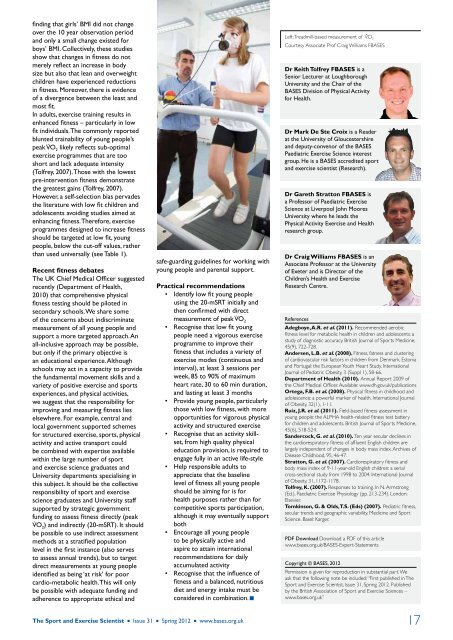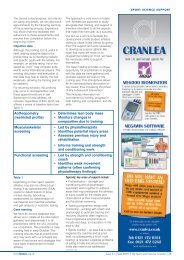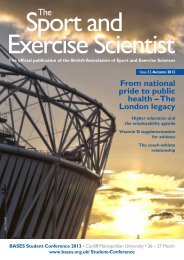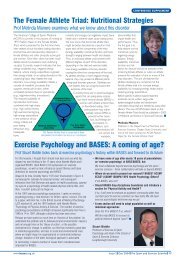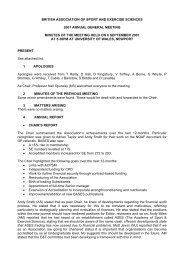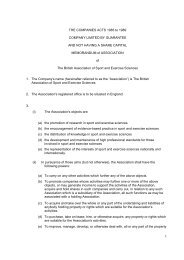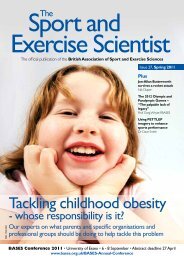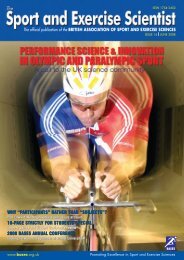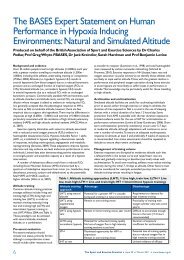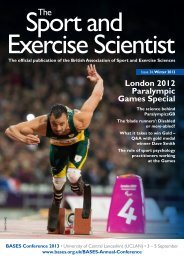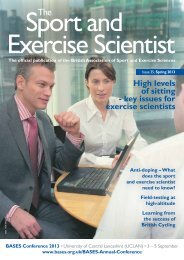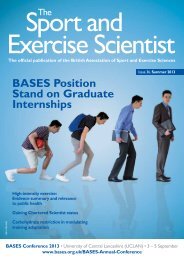Issue 31 Spring 2012 - Bases
Issue 31 Spring 2012 - Bases
Issue 31 Spring 2012 - Bases
You also want an ePaper? Increase the reach of your titles
YUMPU automatically turns print PDFs into web optimized ePapers that Google loves.
finding that girls’ BMI did not change<br />
over the 10 year observation period<br />
and only a small change existed for<br />
boys’ BMI. Collectively, these studies<br />
show that changes in fitness do not<br />
merely reflect an increase in body<br />
size but also that lean and overweight<br />
children have experienced reductions<br />
in fitness. Moreover, there is evidence<br />
of a divergence between the least and<br />
most fit.<br />
In adults, exercise training results in<br />
enhanced fitness – particularly in low<br />
fit individuals. The commonly reported<br />
blunted trainability of young people’s<br />
peak VO 2 likely reflects sub-optimal<br />
exercise programmes that are too<br />
short and lack adequate intensity<br />
(Tolfrey, 2007). Those with the lowest<br />
pre-intervention fitness demonstrate<br />
the greatest gains (Tolfrey, 2007).<br />
However, a self-selection bias pervades<br />
the literature with low fit children and<br />
adolescents avoiding studies aimed at<br />
enhancing fitness. Therefore, exercise<br />
programmes designed to increase fitness<br />
should be targeted at low fit, young<br />
people, below the cut-off values, rather<br />
than used universally (see Table 1).<br />
Recent fitness debates<br />
The UK Chief Medical Officer suggested<br />
recently (Department of Health,<br />
2010) that comprehensive physical<br />
fitness testing should be piloted in<br />
secondary schools. We share some<br />
of the concerns about indiscriminate<br />
measurement of all young people and<br />
support a more targeted approach. An<br />
all-inclusive approach may be possible,<br />
but only if the primary objective is<br />
an educational experience. Although<br />
schools may act in a capacity to provide<br />
the fundamental movement skills and a<br />
variety of positive exercise and sports<br />
experiences, and physical activities,<br />
we suggest that the responsibility for<br />
improving and measuring fitness lies<br />
elsewhere. For example, central and<br />
local government supported schemes<br />
for structured exercise, sports, physical<br />
activity and active transport could<br />
be combined with expertise available<br />
within the large number of sport<br />
and exercise science graduates and<br />
University departments specialising in<br />
this subject. It should be the collective<br />
responsibility of sport and exercise<br />
science graduates and University staff<br />
supported by strategic government<br />
funding to assess fitness directly (peak<br />
VO 2 ) and indirectly (20-mSRT). It should<br />
be possible to use indirect assessment<br />
methods at a stratified population<br />
level in the first instance (also serves<br />
to assess annual trends), but to target<br />
direct measurements at young people<br />
identified as being ‘at risk’ for poor<br />
cardio-metabolic health. This will only<br />
be possible with adequate funding and<br />
adherence to appropriate ethical and<br />
safe-guarding guidelines for working with<br />
young people and parental support.<br />
Practical recommendations<br />
• Identify low fit young people<br />
using the 20-mSRT initially and<br />
then confirmed with direct<br />
measurement of peak VO 2<br />
• Recognise that low fit young<br />
people need a vigorous exercise<br />
programme to improve their<br />
fitness that includes a variety of<br />
exercise modes (continuous and<br />
interval), at least 3 sessions per<br />
week, 85 to 90% of maximum<br />
heart rate, 30 to 60 min duration,<br />
and lasting at least 3 months<br />
• Provide young people, particularly<br />
those with low fitness, with more<br />
opportunities for vigorous physical<br />
activity and structured exercise<br />
• Recognise that an activity skillset,<br />
from high quality physical<br />
education provision, is required to<br />
engage fully in an active life-style<br />
• Help responsible adults to<br />
appreciate that the baseline<br />
level of fitness all young people<br />
should be aiming for is for<br />
health purposes rather than for<br />
competitive sports participation,<br />
although it may eventually support<br />
both<br />
• Encourage all young people<br />
to be physically active and<br />
aspire to attain international<br />
recommendations for daily<br />
accumulated activity<br />
• Recognise that the influence of<br />
fitness and a balanced, nutritious<br />
diet and energy intake must be<br />
considered in combination.<br />
Left: Treadmill-based measurement of VO 2<br />
Courtesy Associate Prof Craig Williams FBASES<br />
Dr Keith Tolfrey FBASES is a<br />
Senior Lecturer at Loughborough<br />
University and the Chair of the<br />
BASES Division of Physical Activity<br />
for Health.<br />
Dr Mark De Ste Croix is a Reader<br />
at the University of Gloucestershire<br />
and deputy-convenor of the BASES<br />
Paediatric Exercise Science interest<br />
group. He is a BASES accredited sport<br />
and exercise scientist (Research).<br />
Dr Gareth Stratton FBASES is<br />
a Professor of Paediatric Exercise<br />
Science at Liverpool John Moores<br />
University where he leads the<br />
Physical Activity Exercise and Health<br />
research group.<br />
Dr Craig Williams FBASES is an<br />
Associate Professor at the University<br />
of Exeter and is Director of the<br />
Children’s Health and Exercise<br />
Research Centre.<br />
References<br />
Adegboye, A.R. et al. (2011). Recommended aerobic<br />
fitness level for metabolic health in children and adolescents: a<br />
study of diagnostic accuracy. British Journal of Sports Medicine,<br />
45(9), 722-728.<br />
Andersen, L.B. et al. (2008). Fitness, fatness and clustering<br />
of cardiovascular risk factors in children from Denmark, Estonia<br />
and Portugal: the European Youth Heart Study. International<br />
Journal of Pediatric Obesity, 3 (Suppl 1), 58-66.<br />
Department of Health (2010). Annual Report 2009 of<br />
the Chief Medical Officer. Available: www.dh.gov.uk/publications<br />
Ortega, F.B. et al. (2008). Physical fitness in childhood and<br />
adolescence: a powerful marker of health. International Journal<br />
of Obesity, 32(1), 1-11.<br />
Ruiz, J.R. et al. (2011). Field-based fitness assessment in<br />
young people: the ALPHA health-related fitness test battery<br />
for children and adolescents. British Journal of Sports Medicine,<br />
45(6), 518-524.<br />
Sandercock, G. et al. (2010). Ten year secular declines in<br />
the cardiorespiratory fitness of affluent English children are<br />
largely independent of changes in body mass index. Archives of<br />
Disease Childhood, 95, 46-47.<br />
Stratton, G. et al. (2007). Cardiorespiratory fitness and<br />
body mass index of 9-11-year-old English children: a serial<br />
cross-sectional study from 1998 to 2004. International Journal<br />
of Obesity, <strong>31</strong>, 1172-1178.<br />
Tolfrey, K. (2007). Responses to training. In N. Armstrong<br />
(Ed.), Paediatric Exercise Physiology (pp. 213-234). London:<br />
Elsevier.<br />
Tomkinson, G. & Olds, T.S. (Eds) (2007). Pediatric fitness,<br />
secular trends and geographic variability. Medicine and Sport<br />
Science. Basel: Karger.<br />
PDF Download Download a PDF of this article<br />
www.bases.org.uk/BASES-Expert-Statements<br />
Copyright © BASES, <strong>2012</strong><br />
Permission is given for reproduction in substantial part. We<br />
ask that the following note be included: “First published in The<br />
Sport and Exercise Scientist, <strong>Issue</strong> <strong>31</strong>, <strong>Spring</strong> <strong>2012</strong>. Published<br />
by the British Association of Sport and Exercise Sciences –<br />
www.bases.org.uk”<br />
The Sport and Exercise Scientist n <strong>Issue</strong> <strong>31</strong> n <strong>Spring</strong> <strong>2012</strong> n www.bases.org.uk<br />
17


